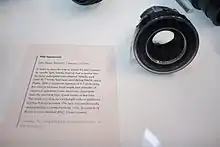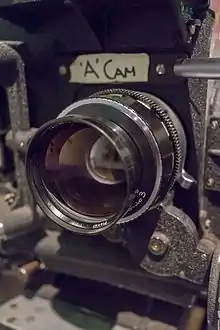Carl Zeiss Planar 50mm f/0.7
The Carl Zeiss Planar 50mm f/0.7 is one of the largest relative aperture (fastest) lenses in the history of photography.[1] The lens was designed and made specifically for the NASA Apollo lunar program to capture the far side of the Moon in 1966.[2][3]

Lens on display during the Stanley Kubrick exhibition.

Lens attached to camera as used for Kubrick's Barry Lyndon
Stanley Kubrick used these lenses when shooting his film Barry Lyndon, which allowed him to shoot scenes lit only by candlelight.[4][5]
In total there were only 10 lenses made. One was kept by Carl Zeiss, six were sold to NASA, and three were sold to Kubrick.[1]
See also
References
- "World's fastest lens: Zeiss 50mm f/0.7", Ogiroux, Google, archived from the original on 2009-03-09.
- Hollywood, NASA, and the chip industry put their trust in Carl Zeiss
- Kämmerer, Dr. J. "When is it advisable to improve the quality of camera lenses?" (PDF). Optics & Photography Symposium (excerpt from a lecture). Les Baux. Archived from the original (PDF) on 2015-04-02. Retrieved 2013-12-11.
- DiGiulio, Ed, "Two Special Lenses for Barry Lyndon", American Cinematographer, Visual memory,
How the stringent demands of a purist-perfectionist film-maker led to the development of two valuable new cinematographic tools
. - This Month's Object: the Zeiss lens f/0.7 Archived February 11, 2012, at the Wayback Machine
External links
- History of fast 35mm and small format film lenses
- Photo of the lens
- A schematic view of the optical design of the lens
- f0.7 – Ultrafast Lenses – Legends, budget options, modding, and testing – Epic Episode #9. YouTube. Media Division. Includes a discussion of the lens and how it was fitted to a movie camera for shooting Barry Lyndon
- (in Italian) OMAGGIO ALL'IMMORTALE KUBRICK ED AL MITICO PLANAR 50mm f/0,7
- (in French) # sk Objectifs ultra-lumineux
This article is issued from Wikipedia. The text is licensed under Creative Commons - Attribution - Sharealike. Additional terms may apply for the media files.